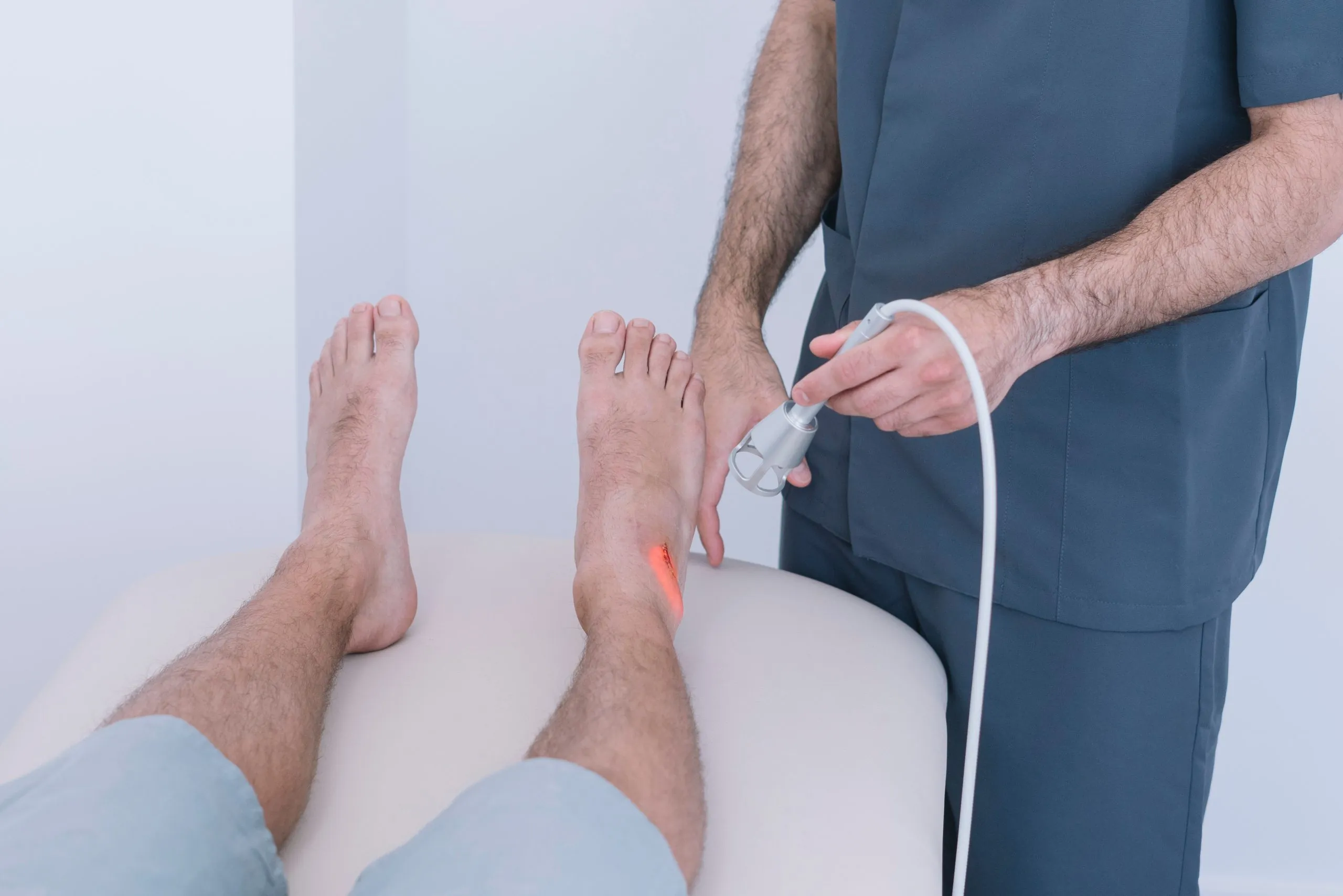Minimally invasive and highly effective, the therapeutic laser is a modern treatment for foot pain.
The laser treatment performed in the clinic relies on technology that thoroughly heals the damaged tissue through photobiomodulation.
This method accelerates the body’s natural healing process, similarly to ShockWave therapy.
The therapeutic laser treatment provides relief from chronic pain, acute pain as well as post-surgery complaints.
The science behind the laser therapy
This treatment uses safe beams of light, also known as high-power laser therapy.
When these light beams hit the skin, they penetrate the structures at the surface. Adding slight pressure may also allow the laser to reach deeper into the affected tissues.
Once they have penetrated the epidermis, the beams of radiation that reach the tissue are absorbed by melanin and hemoglobin.
As a result, the patient feels almost immediate relief when this energetic phenomenon is then converted into heat.
In general, the body’s reactions to laser treatment include:
- Vasodilation
- Increased blood circulation
- Reduction of tissue inflammation
- Reduction of pain
- Acceleration of the healing process
- Recovery of damaged tissue
The treatment’s results are influenced by exposure time, light pulse frequency and beam width.
The podiatrist is responsible for determining these settings after they have made an exact diagnosis of what problem is affecting the foot.
Conditions that can be treated by the therapeutic laser
As a method proven by science, laser therapy is an effective treatment for pain associated with a wide range of musculoskeletal problems.
Among other things, it can help with:
- Pain associated with osteoarthritis
- Stiffness or pain stemming from rheumatoid arthritis
- Chronic or acute low back pain
- Pain after surgery
- Sports injuries
- Achilles tendinitis
- Neuropathic pain
- Plantar fasciitis
- Muscle strain
- Arthrosis of the big toe (hallux rigidus)
- Morton’s neuroma
- Bursitis of the knee
- The stress fracture
- Arthrosis of the knee
- Metatarsalgia
- Skin conditions like diabetic foot ulcer, eczema or psoriasis.
The many benefits of the therapeutic laser
Minimally invasive and quick to perform, the laser procedure inflicts little pain and offers several therapeutic benefits.
Among those benefits, it:
- Represents a good alternative or supplement to foot surgery
- Has an almost immediate pain relieving effect
- Has an anti-inflammatory effect
- Can complement drug therapy
- Allows treatment of both superficial tissue and deeper musculoskeletal structures
- Activates and accelerates the body’s various healing mechanisms
- Contributes to muscle recovery and reduces the risk of sports injuries
- Provides relief in the long term
- Can be adapted to problems of varying degrees
- The therapeutic laser device is free of potentially harmful noise or vibration
Side effects and contraindications
Laser therapy has no known side effects, unlike other less conservative treatments.
The risk of burns is virtually nonexistent as the laser does not emit heat. The only possible side effect is the laser’s light, which may cause eye strain.
Of course, like many other pain management options, the therapeutic laser is not for everyone.
Certain conditions make the use of this treatment inadvisable:
- A malignant tumor near the treatment’s target area
- Presence of tattoos in the sore area
The number of sessions required is usually proportional to the severity of the condition.
However, you can already notice the first long-lasting positive effects between the 2nd and 4th session.
How does a therapeutic laser session proceed?
Before the laser treatment begins in a clinic, the podiatrist must first examine the patient.
This examination has for purpose to pinpoint the source of the pain and what may be causing it.
A biomechanical exam, ultrasound of the foot or digital x-ray will likely be used to refine the diagnosis results.
Once the podiatrist has made a clear diagnosis, they will proceed as follows:
- The podiatrist determines the size of the area to be treated and the appropriate energy dosage for the condition.
- The patient is advised to wear goggles to protect their eyes from the rays.
- The podiatrist performs the treatment by making even, continuous movements over the target area. The laser applicator remains perpendicular to the skin surface at all times.
- The podiatrist repeats the therapeutic routine for 5 to 10 minutes, altering the pressure applied as needed.
- Depending on the patient’s condition, the treatment can continue over several weeks.
The podiatrist can also prescribe laser therapy to accompany other complementary treatments.
The therapeutic laser is a reliable alternative to traditional painkillers
The therapeutic laser treatment is not a pseudoscientific remedy, but a fast and reliable method for pain management.
This adaptable technique can be effective for skin problems of the foot as well as for painful diseases of the musculoskeletal system.
Laser therapy may just be the right thing for you, if you need to relieve pain in a quick and effective fashion, without resorting to surgery. Consult your podiatry clinic today to benefit from the therapeutic laser treatment.

